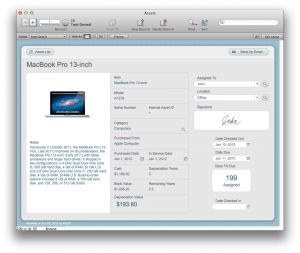FileMaker development experiences with FileMaker 12
FileMaker 12 was released in April 2012. Since that time, we have developed some databases exclusive to the new version and have learned a lot about the new features and functionality. I’d like to share some of our experiences and thoughts as you consider using the latest version.
Not since FileMaker 7 was released back in 2003 has there been such a milestone in the software product line. Back then, upgrading FileMaker 4, 5, and 6 databases was a big deal and often times complex, but necessary: FileMaker 6 stopped being available for purchase, and FileMaker 6 server was not supported on newer version of server OS or natively on Intel Macs. But the benefits of FileMaker 7 far outweighed the inconveniences of upgrading. Finally multiple tables, script triggers, new advanced calculations became possible.
The release of FileMaker 12 is the next major milestone and will require some database upgrading for those that want to leverage the new features or develop new database systems from scratch. Other than the fact that earlier versions of FileMaker are not available for purchase, I am unaware of any specific hardware or software limitation on FileMaker 10 or 11.
Probably the biggest feature improvement with 12 is how the system can handle container objects, or embedded files. You’ve been able to “add” files to a FileMaker database as a sort of DMS for a while. The problem has always been performance and corruption. If you wanted to add a 100K image file to the database, you’d drag it in and the database size would increase 100K. That posed a serious scaling issue for those that pushed it. 5GB database files do not come online very quick. Now, containers are handled as references and the underlying database can save file to a computers file system. One database we recently developed allows a wine distributer to publish new sales print material for their products using a custom print environment and Adobe Acrobat. I expect the system to generate thousands of PDFs over its lifetime and I’ve been very impressed with the lack of performance hit as the system has grown.
Big strides have been made for iPad/iOS support. There are integrated themes between the desktop and mobile versions and FileMakerGo is now free. We’ve built systems for those in healthcare and found the increased performance we were waiting for on the mobile devices.
Improved charting capabilities will provide more graphic interface options with data reports. Gone are the days of complex Flash chart plug-ins. Although we haven’t utilized the new charts to their full extent yet, these are going to be great addition to the report options available for management.
Some of my favorite new smaller features are also worth mentioning. These little functions have helped reduce development time and removed some long-standing workarounds for on some of the more complex systems. A recent clinical trial database project we’re working on for a pharmaceutical client is all over these features:
OnTabSwitch script trigger and Get(TriggerTargetTabPanel) function – interactive layouts can now be easily update with out require special buttons or scripts
Get(UUID) function – universally unique database ID’s now don’t require a custom function
ExecuteSQL function – now there is support for more complex multiple queries and relationships.
Overall, the next generation of FileMaker has been build with the iPad/iOS in mind. Container objects and charts were two areas the Go version lacked. With increased performance on the iPad, the desktop version automatically benefits.
Our experiences with FileMaker development in version 12 have been very positive for us and our clients.
FileMaker server 12 is fully compatible with MacOS X Server 10.6.8 and higher as well as Windows Server 2003 and higher.
Scott Morabito.
–
TechTonic helps organizations build apps, integrate mobile devices, and deploy iPads. Through a process of strategic consulting, IT proficiency, and industry experience, the TechTonic teams assist Boston and New England based businesses and schools with their mobile initiative.






